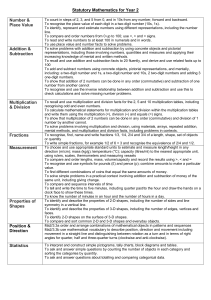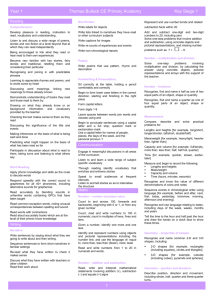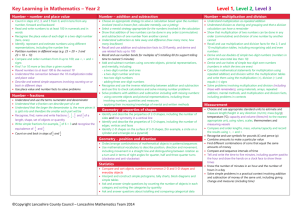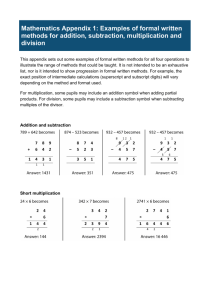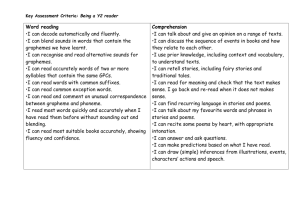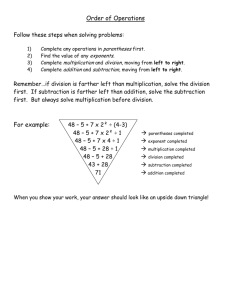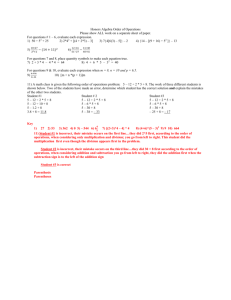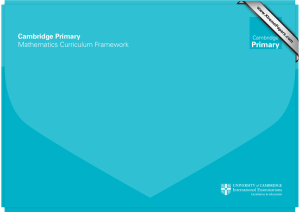Curriculum Overview 2015/16 - Thomas Bullock Church of England
advertisement
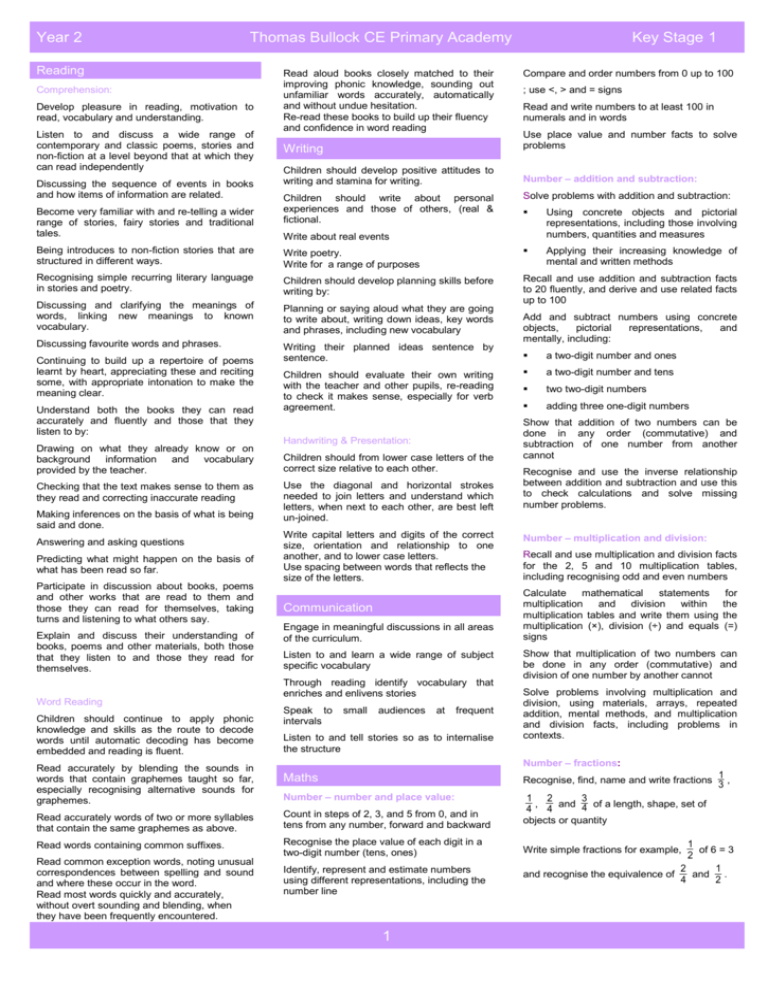
Year 2 Thomas Bullock CE Primary Academy Reading Comprehension: Develop pleasure in reading, motivation to read, vocabulary and understanding. Listen to and discuss a wide range of contemporary and classic poems, stories and non-fiction at a level beyond that at which they can read independently Discussing the sequence of events in books and how items of information are related. Become very familiar with and re-telling a wider range of stories, fairy stories and traditional tales. Read aloud books closely matched to their improving phonic knowledge, sounding out unfamiliar words accurately, automatically and without undue hesitation. Re-read these books to build up their fluency and confidence in word reading Key Stage 1 Compare and order numbers from 0 up to 100 ; use <, > and = signs Read and write numbers to at least 100 in numerals and in words Writing Use place value and number facts to solve problems Children should develop positive attitudes to writing and stamina for writing. Number – addition and subtraction: Children should write about personal experiences and those of others, (real & fictional. Solve problems with addition and subtraction: Using concrete objects and pictorial representations, including those involving numbers, quantities and measures Applying their increasing knowledge of mental and written methods Write about real events Being introduces to non-fiction stories that are structured in different ways. Write poetry. Write for a range of purposes Recognising simple recurring literary language in stories and poetry. Children should develop planning skills before writing by: Discussing and clarifying the meanings of words, linking new meanings to known vocabulary. Planning or saying aloud what they are going to write about, writing down ideas, key words and phrases, including new vocabulary Recall and use addition and subtraction facts to 20 fluently, and derive and use related facts up to 100 Discussing favourite words and phrases. Writing their planned ideas sentence by sentence. Continuing to build up a repertoire of poems learnt by heart, appreciating these and reciting some, with appropriate intonation to make the meaning clear. Understand both the books they can read accurately and fluently and those that they listen to by: Drawing on what they already know or on background information and vocabulary provided by the teacher. Checking that the text makes sense to them as they read and correcting inaccurate reading Making inferences on the basis of what is being said and done. Answering and asking questions Predicting what might happen on the basis of what has been read so far. Participate in discussion about books, poems and other works that are read to them and those they can read for themselves, taking turns and listening to what others say. Explain and discuss their understanding of books, poems and other materials, both those that they listen to and those they read for themselves. Word Reading Children should continue to apply phonic knowledge and skills as the route to decode words until automatic decoding has become embedded and reading is fluent. Read accurately by blending the sounds in words that contain graphemes taught so far, especially recognising alternative sounds for graphemes. Children should evaluate their own writing with the teacher and other pupils, re-reading to check it makes sense, especially for verb agreement. Handwriting & Presentation: Children should from lower case letters of the correct size relative to each other. Use the diagonal and horizontal strokes needed to join letters and understand which letters, when next to each other, are best left un-joined. Write capital letters and digits of the correct size, orientation and relationship to one another, and to lower case letters. Use spacing between words that reflects the size of the letters. Communication Engage in meaningful discussions in all areas of the curriculum. Listen to and learn a wide range of subject specific vocabulary Through reading identify vocabulary that enriches and enlivens stories Speak to intervals small audiences at frequent Listen to and tell stories so as to internalise the structure Add and subtract numbers using concrete objects, pictorial representations, and mentally, including: a two-digit number and ones a two-digit number and tens two two-digit numbers adding three one-digit numbers Show that addition of two numbers can be done in any order (commutative) and subtraction of one number from another cannot Recognise and use the inverse relationship between addition and subtraction and use this to check calculations and solve missing number problems. Number – multiplication and division: Recall and use multiplication and division facts for the 2, 5 and 10 multiplication tables, including recognising odd and even numbers Calculate mathematical statements multiplication and division within multiplication tables and write them using multiplication (×), division (÷) and equals signs for the the (=) Show that multiplication of two numbers can be done in any order (commutative) and division of one number by another cannot Solve problems involving multiplication and division, using materials, arrays, repeated addition, mental methods, and multiplication and division facts, including problems in contexts. Number – fractions: Read accurately words of two or more syllables that contain the same graphemes as above. Count in steps of 2, 3, and 5 from 0, and in tens from any number, forward and backward 1 Recognise, find, name and write fractions 3 , 1 2 3 , and 4 of a length, shape, set of 4 4 objects or quantity Read words containing common suffixes. Recognise the place value of each digit in a two-digit number (tens, ones) Write simple fractions for example, Read common exception words, noting unusual correspondences between spelling and sound and where these occur in the word. Read most words quickly and accurately, without overt sounding and blending, when they have been frequently encountered. Maths Number – number and place value: Identify, represent and estimate numbers using different representations, including the number line 1 1 of 6 = 3 2 2 1 and recognise the equivalence of and . 4 2 Year 2 Thomas Bullock CE Primary Academy Key Stage 1 Measurement: Science Organise,, store , manipulate and retrieve data Choose and use appropriate standard units to Animals, including humans in a range of digital formats. estimate and measure length/height in any direction (m/cm); mass (kg/g); temperature (°C); capacity (litres/ml) to the nearest appropriate unit, using rulers, scales, thermometers and measuring vessels Notice that animals, including humans, have offspring which grow into adults. Communicate safely and respectfully online, keeping personal information private and recognise common uses of information technology beyond school. Compare and order lengths, mass, volume/capacity and record the results using >, < and = Recognise and use symbols for pounds (£) and pence (p); combine amounts to make a particular value Find out about and describe the basic needs of animals, including humans, for survival (water, food and air) Describe the importance for humans of exercise, eating the right amounts of different types of food, and hygiene. Plants Find different combinations of coins that equal the same amounts of money Observe and describe how seeds and bulbs grow into mature plants. Solve simple problems in a practical context involving addition and subtraction of money of the same unit, including giving change Find out and describe how plants need for water, light and a suitable temperature to grow and stay healthy. Compare and sequence intervals of time Tell and write the time to five minutes, including quarter past/to the hour and draw the hands on a clock face to show these times Know the number of minutes in an hour and the number of hours in a day. Geometry – properties of shapes: Identify and describe the properties of 2-D shapes, including the number of sides and line symmetry in a vertical line Identify and describe the properties of 3-D shapes, including the number of edges, vertices and faces Identify 2-D shapes on the surface of 3-D shapes [for example, a circle on a cylinder and a triangle on a pyramid] Living Things and Their Habitats Explore and compare the differences between things that are living and dead, and things that have never been alive. Identify that most living things live in habitats to which they are suited and describe how different habitats provide for the basic needs of different kinds of animals and plants, and how they depend on each other. Identify and name a variety of common plants and animals in their habitats, including microhabitats. Describe ho animals obtain their food from plants and other animals, using the idea of a simple food chain, and identify and name different sources of food. Compare and sort common 2-D and 3-D shapes and everyday objects. Uses of Everyday Materials Geometry – position and direction: Identify and compare the suitability of a variety of everyday materials, including wood, metal, plastic, glass, brick, rock, paper, and cardboard for particular uses. Order and mathematical sequences arrange combinations of objects in patterns and Use mathematical vocabulary to describe position, direction and movement, including movement in a straight line and distinguishing between rotation as a turn and in terms of right angles for quarter, half and three-quarter turns (clockwise and anti-clockwise). Statistics: Interpret and construct simple pictograms, tally charts, block diagrams and simple tables Ask and answer simple questions by counting the number of objects in each category and sorting the categories by quantity Ask and answer questions about totalling and comparing categorical data. Find out how the shapes of solid objects made form some materials can be changed by squashing, bending, twisting and stretching. Art and Design Use experiences and ideas as the inspiration for artwork. Share ideas using drawing, painting and sculpture. Explore a variety of techniques Learn about the work of a range of artists, artisans and designers. Design Technology Design Design purposeful, functional, appealing products for themselves and other users based on design criteria. Generate develop, model and communicate their ideas through talking, drawing, templates, mock-ups and where appropriate, information technology. Make Select from and use a wide range of tools and equipment to perform practical tasks such as cutting, shaping, joining and finishing. Select from and use a wide range of materials and components, including construction materials, textiles and ingredients, according to their characteristics. Evaluate Explore and evaluate a range of existing products. Evaluate their ideas and products against design criteria. Technical Knowledge Explore and use mechanisms, such as levers, sliders, wheels and axels, inn their products. Cooking and Nutrition Use the basic principles of healthy and varied diet to prepare dishes. Understand where food comes from. Geography Locationall Knowledge Name and locate the world’s seven continents and five oceans. Name, locate and identify characteristics of the four countries and capital cities of the United Kingdom and its surrounding seas. Human and Physical Geography Identify seasonal and daily weather patterns in the United kingdom and the location of hot and cold areas of the world in relation to the Equator and the North and South Poles. Use aerial photographs and plan perspectives to recognise landmarks and basic human physical features; devise a simple map; and construct basic symbols in a key. History Changes within living memory. Computing Understand what algorithms are, how they are implemented as programs on digital devices, and that programmes executed by following a sequence of instructions. Events beyond living memory significant nationally or globally. that are Write and test simple programs. The lives of significant individuals in the past who have contributed to national and international. Some should be used to compare aspects of life in different. Use logical reasoning to predict the behaviour of simple programmes. Significant events, people and places in their own locality 2 Year 2 Thomas Bullock CE Primary Academy Music Use their voices expressively by singing songs and speaking chants and rhymes. Play tuned and untuned instruments musically. Listen with concentration and understanding to a range of high-quality live and record music Make and combine sounds using the interrelated dimensions of music. Physical Education Participate in team games, developing simple tactics for attacking and defending Perform dances patterns. using simple movement R.E Believing What do you believe? How is this different or similar to what others believe? 3 Key Stage 1
